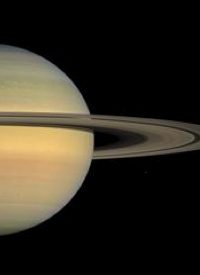
Launched in 1997, the Cassini probe to Saturn completed its initial four-year mission in June 2008. The trip from Earth to Saturn took roughly seven years and entailed 2.2 billion miles. Although Cassini’s nuclear power supply caused a brief controversy among environmentalists who fretted that the probe would come crashing down, spilling its 72 pounds of plutonium in Earth’s environment, Cassini has quietly gone about its work, rarely drawing much attention from the public except at the more “telegenic” moments of the mission.
The mission reached its indisputable “high point” with the release and descent of the Huygens probe to the surface of Titan, one of Saturn’s moons. The images of Titan were among some of the most significant in the history of America’s space program since the successes of the Viking landers on Mars in the 1970s.
However, the Cassini mission was not limited to the study of Titan; significant advances in the study of other moons, as well as the rings of Saturn, occurred throughout the mission. (Those who are interested in learning more of the details of Cassini’s discoveries may visit the mission website.) Thus the decision was made to extend Cassini’s work for two additional years, as the “Cassini Equinox Mission.”
Cassini completed its initial four-year mission to explore the Saturn System in June 2008. Now, the healthy spacecraft is working overtime on the Cassini Equinox Mission, seeking answer to new questions raised in Cassini’s first years at Saturn.
The mission’s extension, through September 2010, is named for the Saturnian equinox, which occurs in August 2009 when the sun will shine directly on the equator and then begin to illuminate the northern hemisphere and the rings’ northern face. Cassini will observe seasonal changes brought by the changing sun angle on Saturn, the rings and moons, which were illuminated from the south during the mission’s first four years.
Many repeat visits are planned for Cassini at the moons Titan and Enceladus – both important targets of the Equinox Mission.
Among the latest discoveries are strange patches of color on five of Saturn’s moons. According to Space.com:
Some of the patterns have been seen before, but others took scientists by surprise, suggesting dynamic interactions between the moons and other particles orbiting around Saturn.
The maps of Mimas, Enceladus, Tethys, Dione, and Rhea were created from images taken by NASA’s Cassini spacecraft and were presented by Paul Schenk of Houston’s Lunar and Planetary Institute at a recent meeting of the American Astronomical Society….
Some of the most striking patterns are revealed when the brightness of the surface in infrared light is divided by the brightness in the ultraviolet part of the spectrum, which gives the so-called redness of the surface. The maps reveal that except for Mimas, all the inner moons are redder on their trailing hemispheres.
This reddening is strongest at the centers of the trailing face (like the center of a bulls-eye). The leading faces of the moons also appear to be redder in their centers, though the redness is weaker than for the trailing hemisphere.
Seeing this pattern on both hemispheres is difficult to explain because most processes that would color the surface in this way would only affect one hemisphere or the other.
Scientists are presently exploring several possible explanations to account for the strange coloration, including debris from one of Saturn’s rings. Other phenomena, however, are even more surprising:
Another surprise was the discovery of a very narrow and straight band of discrete ultraviolet-bright features very close to Rhea’s equator. At higher resolution, the band appears as bluish splotch-marks that form a very narrow chain only a few kilometers wide across the center of the leading hemisphere of Rhea. These features are seen on no other icy satellite of Saturn.
The pattern of the splotches suggests they are the result of impacts from Rhea’s dusty ring system, first proposed in 2008.
Cassini’s next encounter will be with the moon Enceladus on November 2.



